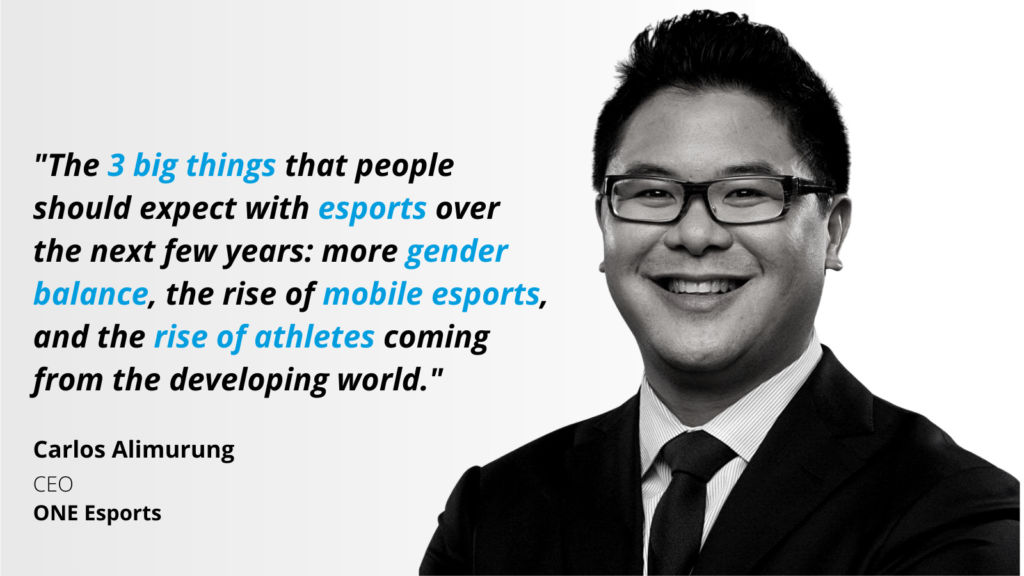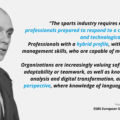01 Jul Have you met…Carlos Alimurung? – Esports: the future of sports and entertainment
Esports, or better known as the sector that began as a subset of entertainment, is now positioned as one of the top and most dynamic industries in the word. It is a blooming business where the most powerful brands seek to be part of this compelling market.
Trends in this area are changing and evolving at a high speed, and catching up with what’s going on in esports has to be on the priorities list for each sports organization today in order to grow and stay on top.
This month, we speak to Carlos Alimurung, CEO of ONE Esports, to learn not only about trend in the esports sector, but also about the nature and true essence of this big and exciting world.
– Question: Carlos, please, introduce yourself to our readers.
– Answer: I’m the CEO of ONE Esports. I have been at ONE Esports for about two years, based out of Singapore. In these two years, we have built ONE Esports to be the biggest, most influential esports media company in Southeast Asia. Our ambitions are global, and we are always looking to grow and scale the business further and spread the good word of esports to the rest of the world.
– Q: What were you doing before coming to ONE Esports?
– A: Before joining ONE Esports, I was the chief business officer of a company called Battlefy, a startup based out of Vancouver. Battlefy is the world’s largest online esports competition platform. Essentially, it is a platform that enables people to create, manage, and market, their own online esports competitions. I was there for about four years.
Before my time at Battlefy, I worked at a company called Univision,which is the largest Spanish language media company in the United States. I had several roles there, the last one being running corporate investments.
Before that I was the head of strategy for consumer electronics at LG Electronics for their North America business and prior to that I was a long-time management consultant for about 8 years.
– Q: Why esports? Do you have some kind of personal passion for this sector?
– A: I am 45 years old and I would categorize my generation as the first one that grew up with video gaming. The people in my generation are now parents, and we know what gaming and esports is, compared to my parents, who had absolutely no clue. I have always been a passionate gamer. When working at Univision, I did a lot of the research and discovered that Hispanic Americans over-indexed on gaming. This is when I started looking deeper at gaming and esports as an investment opportunity for Univision.
It was at this time when I found Battlefy; I was so compelled with the business that I decided to join. For me, gaming has always been a huge passion, and the opportunity to do it professionally and to do it also within the context of a startup checked off a lot of boxes for me. That is why the last 7 years of being in the esports industry has been a dream come true for me.
– Q: Now that you mentioned a generational gap in the sense of understanding esports, what would you say are the differences between esports and traditional sports and what are the similarities?
– A: I spend half of my time trying to explain to people that esports is the future of sports and entertainment, and breaking down the differences between traditional sports and esports.
With that said, I spend the other half of my time telling people that esports is just like sports – if you ask someone why they are fanatical about Real Madrid or the Yankees, they are going to tell you stories of how they went to the stadium, how they love a particular athlete, how they hate the rival team, and how they despise the other athletes on those rival teams.
All those emotions, all those feelings that people have in traditional stick and ball sports – these also exist in esports.
Competitive video gaming (which essentially is esports) has been around for a while – in fact, the first recognized organized video gaming competition occurred in 1972 at Stanford University. Why is it different and more recognized today? It is different because of the context in which we live right now.
When I was in high school, I was a big fan of the NBA. It was Michael Jordan who introduced basketball to me and really got me into the NBA; not necessarily because I was a Chicago Bulls fan. It was because I was a New York Knicks fan, and we were always battling it out with Chicago.
If you had told me in high school that I would have had the opportunity to interact almost on a 1-to-1 basis with Michael Jordan and watch him practice between the games, I would have been an even more fanatical fan of the NBA.
This is what is happening in esports today. Technology has enabled fans to interact with their favorite athletes almost on a 1-to-1 basis on these incredibly distributed platforms like Twitch, YouTube or Facebook. The opportunities in which fans are given to engage with the people who they idolize is one of the big differences between traditional stick and ball sports and esports.
And as a matter of fact, I would argue that many athletes and teams in traditional sports are learning how to interact with their fans now by watching what is happening in esports and gaming. Traditional sports and esports are learning from each other.
– Q: Does it mean that for you the storytelling is more about the player than the team?
– A: At the end of the day, it is the individuals that tug at our hearts. Whether in sports, movies, books or whatever it may be, it’s always individual personalities who draw our attention and capture our hearts and imaginations.
This is part of the mission of ONE Esports; when we look at who is doing the storytelling in esports, we see a massive gap and a huge opportunity to fill that gap. We view our role in the industry and the ecosystem as being storytellers, being that megaphone. And that is why our mission at ONE Esports is to share and celebrate the stories of esports heroes who ignite the world with strength, hope, dreams and inspiration.
We hope that through the hard work we put in, and the stories that we create about our esports heroes, that these athletes will be elevated to the same tier as icons like Messi, Ronaldo, LeBron, Serena Williams, Hamilton, Federer; that is our dream, that is our mission.
– Q: How do you do that? How do you build your storytelling – could you provide an example?
-A: For a lot of different reasons, the esports ecosystem is incredibly flat, meaning it is really distributed. There are companies that do events. There are companies that run esports news sites. There are companies that just work with influencers. Then there are esports teams. Then there are the game developers. This means that the fan experience can be very disjointed. You are hearing one story from the tournament organizer, one story from the news site, one story from the production company that is doing the long form documentary.
At ONE Esports, we believe that the best way to do storytelling is to do it seamlessly.
Why ONE Esports has been so successful in the last two years is because we deliver the entire content stack, not only to our fans but also to our commercial partners through hosting some of the world’s biggest events. We own and operate one of the biggest esports news sites in the world. Our social media has massively scaled close to 400 million monthly unique viewers. We have our own studio that puts out streaming content, and we even have our own data and analytics team that does research on what type of content fans in the community want to consume.
When we work with our brand partners, or when we are telling the stories of these esports heroes to our fans, it is done in a very integrated and seamless way.
– Q: Storytelling is now also in traditional sports; they are learning from esports on how to connect and how to be closer to the fans. Technology plays a big role of in that process. What is this role for you? How important is technology and the use of data for storytelling to reach your fans, the gamers or just a follower?
– A: If you look at traditional sports, the use of data in stick and ball sports is generally a recent phenomenon, existing maybe in the last 10-15 years. The newest generation of baseball, NBA, or football fans, are now growing up with data.
In gaming and esports, data has always been part of the experience. If you look at the screen of a League of Legends or Dota 2 game, it’s full of data – there is all this information and stats on the screen for viewers. So yes, it is true that data has played an integral role in esports from the very beginning.
The way that we use data from the ONE Esports perspective is to customize the content for our readers and our fans. We are constantly trying to understand why people are reading particular articles or news, what’s motivating them to follow a particular team or a particular athlete, and having these insights help us to customize the experience for the people who are interacting with us through our different platforms.
Technology not only plays a role in data and helping drive performance, it also plays a massive role in connecting all of us. One of the reasons competitive organized video gaming competitions in the 70s did not take off is because there wasn’t a broadcasting platform like Twitch or YouTube in existence at the time. If you think about it: sports always originate from somewhere. Tennis from the United Kingdom, baseball in America, right? However, esports – because technology is so inherent to it – was born globally.
– Q: What kind of technologies do you use it in ONE Esports?
– A: At the end of the day, we are a media company. That means we are across all the big social platforms. Obviously, we run our own site, we run live events where we are streaming them. Technology is just part of our daily lives. I would argue that even in traditional sports, technology is playing a massive role. You cannot exclude technology anymore from sports. It plays a part in the camera angles, the customization of what people can view, what platforms they consume the content on.
The interesting thing though is that esports is the tip of the spear in how technology is used to consume sports content. If you look at the average age of not only a fan but probably more importantly an esports sport executive, versus the average age of the sports executives over at the NBA, MLB, NFL or even FIFA –the age difference is massive. I encourage people to look at esports again as the tip of the spear, on how to apply technology not only to distribute your sports content but also to look at how fans engage with athletes and teams.

– Q: Do you think, at some point gaming can become part of traditional sport or they will always exist separately? Furthermore, should sports organizations (who still don’t have this kind of merge created) establish alliances or partnerships or create their spinoffs of esports divisions?
– A: If you are a sports executive in traditional sports, and you are not looking at Esports or gaming at the very least as another engagement point for your sport, I think you are missing out on something, because that is going to be the way that your new generation of fans come in.
If you are a sports executive who is in traditional sports and you are thinking about creating a professional team in esports, then that’s a bigger, more strategic question that really depends on the assets and the capabilities of the team that you’re working with.
However, at the very least, you cannot ignore gaming and esports. It is truly the next generation of fanbase. As I said, look at the average age of a fan of the NBA, NFL or MLB, golf, cricket, rugby, soccer, any traditional sport – the average age is going to be significantly higher than the average age of someone who’s participating and consuming esports content.
I think esports is here to stay. I think it is mainstream already, and I think you are only going to see it seep into more and more parts of our lives.
– Q: And what are the opportunities for sponsorships in esports right now?
– A: It’s not a secret that esports is the future of sports and entertainment. Hundreds of brands have already entered the esports arena. When you look at our portfolio of partners you will find huge regional and international brand names such as Unilever, Toyota, Samsung, Tinder, HP, Intel, and more. ONE Esports has been fortunate enough to work with some of the world’s best brands.
More and more brands are entering this space because they want to access millennials and Gen Z’s. Our research found that esports fans are becoming increasingly gender balanced as well.
The opportunities for brands to enter the space are numerous. I would say though that it takes some guidance and good education on how to enter authentically, which is a service that ONE Esports provides. Authenticity is a big thing for the esports community and certainly we have our own philosophy and beliefs around how brands should develop that credibility and authenticity.
– Q: Would you say that there’s more interest from the brands’ side in esports since the beginning of COVID?
– A: The short answer is yes. If you had talked to me in the beginning of 2020, I would have been very nervous about the business. Obviously, there is a component of our business which is offline, such as running live events with an audience. While marketing budgets have shrunk due to COVID-19, global brands cannot turn their faucets off completely. Luckily for ONE Esports, we were viewed as a high-quality platform for brands to pilot and experiment and get involved with esports. While COVID-19 has certainly accelerated the growth of the industry, at the end of the day, esports was going to keep growing regardless of the pandemic.
COVID-19 also changed the psychology of many marketers – smart and agile businesspersons saw this period as an opportunity to experiment, pilot, and experience new things.
In fact, the team just wrapped up the ONE Esports Dota 2 Singapore Major which generated 274m total views and 1.1m peak concurrent views, making it the second most watched Dota 2 Major in history. We brought on board some renowned regional and international brands for the tournament, including Foodpanda, Netflix, Shopee, Tinder, TikTok, and TUMI. I am confident that our brand partners are going to continue to invest in esports because they had a great experience with us.
– Q: To summarize everything that you said, how do you envision the future of esports? What would you say will esports look like by 2025?
– A: I think there are three big things that people should expect to see in the future of esports.
The first one is something that we have already talked about: esports is going to become way more gender balanced. Right now, depending on the market you are looking at, the gender breakdown is anywhere between 35% to even 45% female. In the coming years, you are going to see this more 50/50.
The second one, certainly the biggest trend in esports, is mobile esports. The vanguard of this movement is in Southeast Asia. With time, we will continue to see mobile esports increasingly grabbing a share of the esports market. Bear in mind that PC and console are not going to go away. PC and console esports will continue growing strongly in developed markets like Europe, China and the United States. However, when you think about the next generation of gamers, they are coming from Southeast Asia, Africa, India, the Middle East, South America, and in these markets, owning an expensive PC or a gaming console at home is prohibitive for many families. Conversely, everyone owns their own smartphones these days.
Another trend we can expect to see is a bigger role for esports athletes coming from the markets that I just mentioned: Southeast Asia, India, the Middle East, Africa, South America. The next generation of esports athletes will come from these markets by riding the mobile esports megatrend.
– Q: What was your most important lesson from 2020?
-A: 2020 is going to be remembered as one of the toughest years for humanity, and the biggest lesson that I learned is that you need to be optimistic. You need to see the glass half full and having this mindset, philosophy, and framework about how life or how business operates is massively important.
We overcame the difficulties of 2020 because of a positive attitude – we operated with the belief that we were going to be successful, and we were going to make it through the storm. I wouldn’t go so far as to say that we have won the battle against COVID-19 as I still think we have a few more tough roads ahead with this virus. Nevertheless, we are still in a better place than we were in as compared to March last year.
So, always remember to be optimistic. This is the is the biggest lesson that I’ve taken from 2020.
– Q: What are your big plans for the rest of this year?
– A: We just recently announced that we are the official international media partner for LPL. LPL is the pro league for League of Legends out of China. Globally speaking, some of the best esports athletes are coming out of that league and so for us to be recognized as the official international media partner is amazing. LPL will use our assets and capabilities in storytelling to evangelize to the world how special these esports athletes are.
We also announced that we have once again partnered with Moonton to host this year’s MPLI in the final quarter of 2021. The 2021 ONE Esports MPLI will feature the best teams across Southeast Asia competing for their share of the US$100,000 prize pool.
We are also going to be working with Toyota for their Gran Turismo sim-racing competition for the second year in a row.
As you can tell, we have some big things coming up. It is certainly going to be an exciting second half of the year for ONE Esports!







